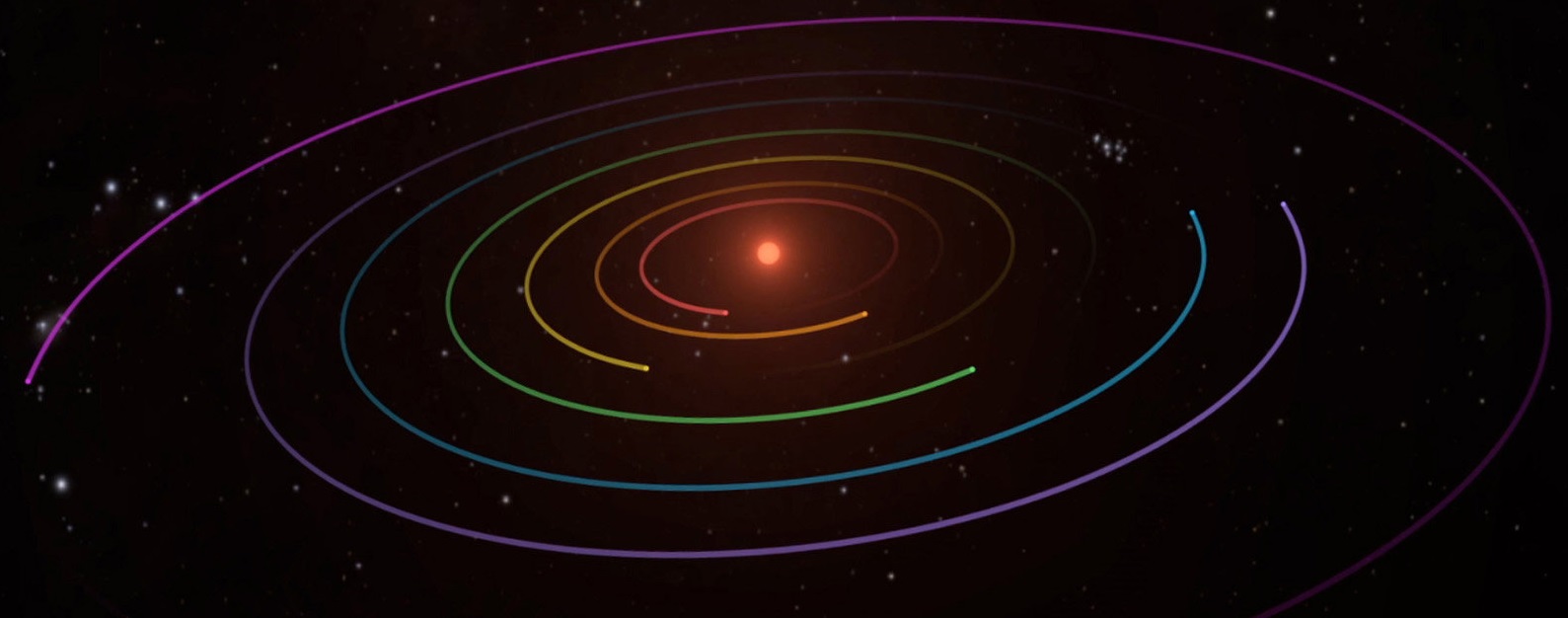|
A visualization of the seven planets
orbiting the star TRAPPIST-1.
NASA/JPL/Caltech
Twenty-five years ago, all the known
planets
were in our own Solar
System. Until 1992, exoplanets
were the stuff of speculation. Thanks to
advances in detection
methods, as of this writing (May 2017), more
than 3,600 exoplanets have been confirmed in more
than 2,700 planetary systems, and there are
billions more to be found in just the Milky
Way Galaxy.
TRAPPIST
(Transit Planets and Planetesimals Small
Telescope) is the name for a pair of robotic
telescopes that made the initial discovery in
2015 of...
TRAPPIST-1
is an exceptional planetary system surrounding
an ultra-cool dwarf star, which is about the
size of our own planet Jupiter but
situated 40 light-years away in the
constellation of Aquarius .
 Exceptional indeed, inasmuch as TRAPPIST-1
comprises a total of seven temperate
terrestrial exoplanets -- the most found in any
exoplanet system discovered so far. They are
tightly packed, with all seven planets whirling
through space well within the orbital dimensions
of our planet Mercury. Exceptional indeed, inasmuch as TRAPPIST-1
comprises a total of seven temperate
terrestrial exoplanets -- the most found in any
exoplanet system discovered so far. They are
tightly packed, with all seven planets whirling
through space well within the orbital dimensions
of our planet Mercury.
For the Trappist Orbits puzzle, let us name the planets
p1, p2, p3, ... p7, and observe...
- Orbital periods ('years') τ1,
τ2, τ3, ... τ7 range from 1.5
to 18.8 earth days.
- Orbital radii r1, r2, r3,
... r7 range from 1.66
to 8.92 Mkm (1.0 to
5.6 Mmi).
- Orbital proximities range from r2-r1
= 0.62 to r7-r6 = 2.07 Mkm (0.4 to 1.3 Mmi).
- Orbital eccentricities e1,
e2, e3, ... e7 are all less than
0.09 -- essentially circular.
Orbital
Resonance
Close as they are to each other, the TRAPPIST-1
planets have not collided for the last few million
years. The seven orbits appear to be
'stable' -- even harmonious...
The linked reference postulates that
orbital
resonance plays a key rôle in assuring 'harmony' among the seven
planets in the Trappist Orbits.
It is easy to show that adjacent Trappist
Orbits have periods that
are ratios of small whole numbers and
thus meet the criterion for orbital resonance...
Consider the first three Trappist
Orbits: τ1 =
1.511, τ2 = 2.422, τ3 =
4.050 earth days...
τ2 / τ1 = 1.603 versus 8/5 = 1.600 --
99.8% agreement
τ3 / τ2 = 1.672 versus 5/3 = 1.667
-- 99.7% agreement
...therefore, while p2
completes 5 orbits, p1 completes 8
orbits and p3 completes 3 orbits.
 Sure enough, using
gazillions of simulations on a supercomputer,
astrophysicists have tested the 'harmony' concept
and confirmed that the present configuration of Trappist Orbits will be sustainable for billions
of years. This puzzle will use a simple
spreadsheet to do the same... Sure enough, using
gazillions of simulations on a supercomputer,
astrophysicists have tested the 'harmony' concept
and confirmed that the present configuration of Trappist Orbits will be sustainable for billions
of years. This puzzle will use a simple
spreadsheet to do the same...
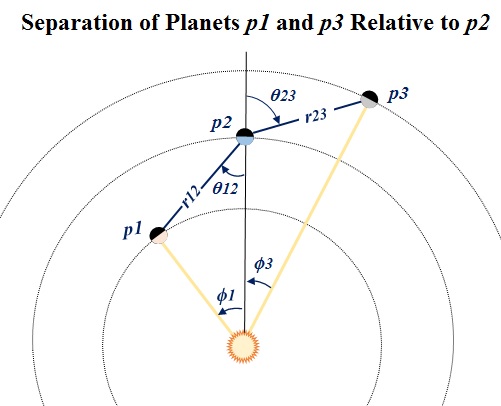
Here is a
snapshot of the first three planets in circular
counterclockwise orbits around TRAPPIST-1.
We observe that p1 has recently
passed p2 where r12 = r2 -
r1, and p2 has recently
passed p3, where r23 = r3 -
r2. Solvers can use this sketch
to derive the distances r12 and r23,
which by Newton's
Law determine the instantaneous
gravitational forces acting between the planets...
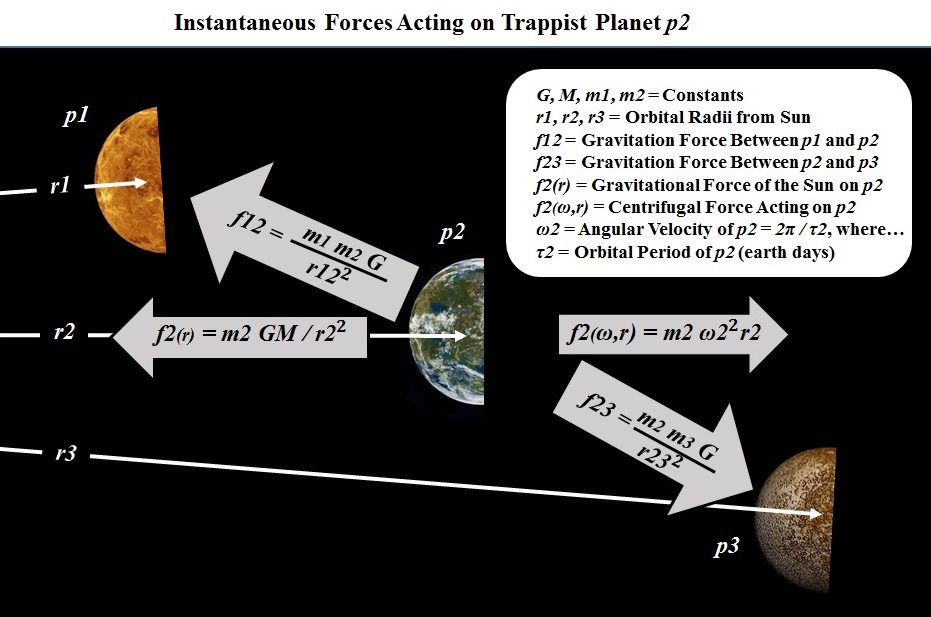
Four
forces are shown acting on p2:
Gravitational
force f2(r) imposed on p2
by the sun and varies inversely with the
square of the orbital radius r22. Centrifugal
force f2(ω,r)
r2 and with the square of the angular
velocity ω22. For a
circular orbit f2(r2) = f2(ω2,r2), thus ω2
= (GM)1/2 r2 -3/2.
Planets p1 and p3 in
adjacent orbits impose gravitational forces f12
and f23 on p2, which
vary inversely with r122 and r232. As planet p1
passes below p2,
ϕ1 = 0, r12 decreases to its minimum, r12
= r2 - r1, and f12
reaches its maximum, f12 =
m1 m2 G / (r2 - r1)2. Likewise, as
planet p2 passes below p3, ϕ3
= 0, r23
decreases to its minimum, r23 = r3 - r2,
and f23 reaches its maximum, f23
= m2 m3 G / (r3 - r2)2.
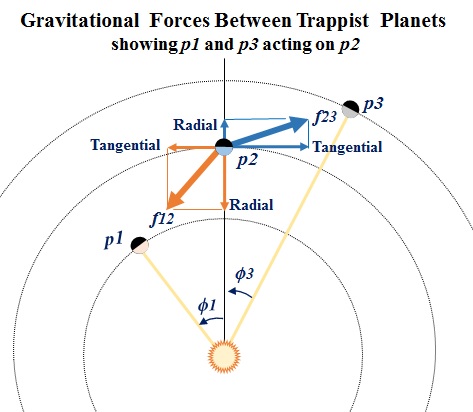
This sketch shows f12
and f23 each decomposed into their
respective Tangential and Radial
components. We observe that...
Planet p1 has
recently passed below p2, and its
gravitational force f12 is now
acting to accelerate p2
tangentially along its orbital path while
simultaneously pulling p2
radially toward the sun.
Planet p2 has recently passed
below p3, and its gravitational
force f23 is now acting to
decelerate p2 tangentially along
its orbital path while simultaneously pulling p2
radially away from the sun.
Newton's
Third Law of Motion, of course, assures that
f12 and f23 apply to
p1 and p3,
respectively, in equal magnitudes and opposite
directions.
 Before taking on the
challenge in the Trappist Orbits puzzle, some solvers may need to
be advised that in orbital
mechanics, the motions of
celestial bodies resulting from applied forces are
counter-intuitive. Accordingly, we
need to indulge in some orbital mechanics here... Before taking on the
challenge in the Trappist Orbits puzzle, some solvers may need to
be advised that in orbital
mechanics, the motions of
celestial bodies resulting from applied forces are
counter-intuitive. Accordingly, we
need to indulge in some orbital mechanics here...
We might acquire an understanding of the subject
at Kerbal
Space Program, which provides a practical
treatment of maneuver
nodes in rocketry.
Maneuver nodes are defined as planned
orbital locations where thrust vectors are
prescribed to accomplish various objectives:
transfer orbit, circularization, rendezvous,
station-keeping. Solvers may regard the 'points of least
separation' between adjacent planets as
'spontaneous maneuver nodes' and treat the components of
gravitational attraction between planets as if
they were orthogonal thrust vectors as produced in
command modules and artificial satellites...
From a circular orbit, a brief Tangential
force applied in the same direction as a
satellite's motion ('prograde') changes the
orbit to elliptical; the satellite will ascend
and reach the highest orbital point (the apoapse) at 180 degrees away
from the point of application ('firing point' in
rocketry); then it will descend back, returning
to the firing point. So too, thrust
applied in the opposite direction of the
satellite's motion ('retrograde') changes the
orbit to elliptical with the lowest orbital
point (the periapse) at 180 degrees away
from the point of application; then it will
ascend back, returning to the firing point.
From any location in an elliptical
orbit, a brief Radial force applied
toward the focus of the orbit -- the sun -- rotates the whole orbit in its
plane through an angle in the direction of the
satellite's motion, thereby moving both the
apoapse and the periapse to new locations still
opposite to each other. The effect is
generally described as orbital
'precession'. A brief force applied away
from the focus of the orbit ('radial-out')
rotates the orbit in its plane through an angle
in the opposite direction from the satellite's
motion, as illustrated in the sketch below...
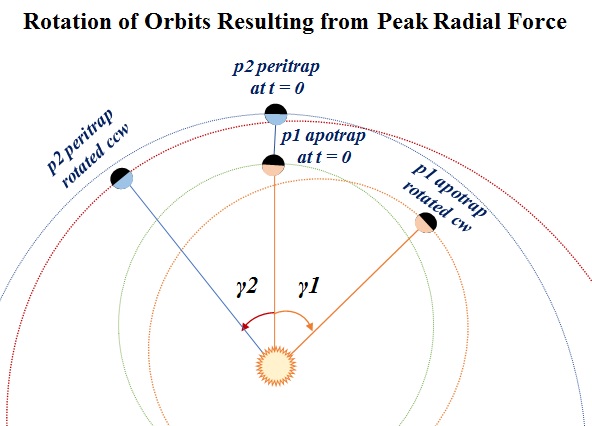
In the sketch above, we have coined the terms
'apotrap' and 'peritrap' for the Trappist Orbits puzzle.
Whenever the elliptical orbits of p1
and p2 happen to become aligned,
such that p1 passes its p1
apotrap just as p2
simultaneously passes its p2 peritrap
directly above, then r12 reaches
its absolute minimum, which results in
radial force f12 reaching its absolute
maximum. The p2 orbit
rotates in its plane through some angle γ2 in the direction of the planet
motion, as indicated by p2 peritrap rotated
ccw. Meanwhile, being acted on
equally in the opposite direction, the p1 orbit
rotates in its plane through some angle γ2 in angle γ1 in the direction opposite to the
planet motion, as indicated by p1 peritrap
rotated cw.
Solvers are invited to make the
following simplifying assumptions:
Three exoplanets p1, p2, p3 are
in circular, coplanar orbits at radii r1,
r2, r3 ,
such that in the time p2 takes to complete 5 orbits, p1
completes 8 orbits and p3
completes 3 orbits.
|
Show that each orbit
will remain stable for some indefinitely
long period of time.
|
GO TO SOLUTION PAGE

|
